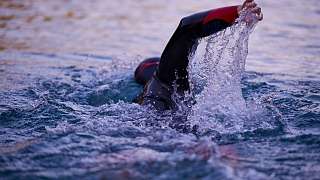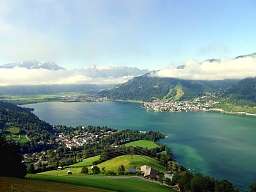Romantik Blog
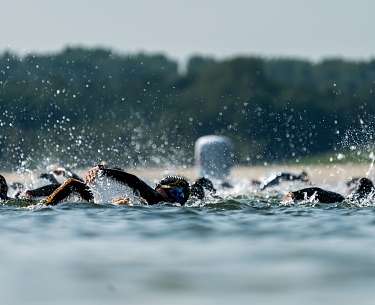
Ironman as an endurance sport
In the beginning it was just a crazy idea. In 1978, some endurance athletes in Hawaii were discussing which discipline would probably have the highest fitness requirements: Running? Swimming? Cycling? One of them suggested just trying it out and doing all three sports in one competition, one right after the other: 3.8 kilometres of swimming. Cycling 180 kilometres. And then quickly run a marathon over 42 kilometres - something for athletes with iron stamina. Hence the name. On 18 February 1978, the first "Ironman" triathlon in history took place on Oahu. Sixteen participants went to the start. Twelve "iron men" reached the finish line.
This origin story of the Ironman fits perfectly with the ever-growing community of enthusiastic triathletes all over the world. Because they are always considered a bit crazy by normal athletes, given the insane distances involved in an Ironman competition.
"The most important thing for professionals and amateurs: never forget that you do it because you love it!" - Jan Frodeno -
Anyone can participate
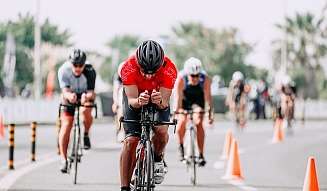
You can also start very small with triathlon, because it is not automatically the same as Ironman. There are many different distances, some of which can be mastered by amateur athletes with a little training. The most common are the following variants:
+ Super Sprint: 400 metre swim, 10 kilometre bike, 2.5 kilometre run.
+ Sprint: 500 or 750 metre swim, 20 kilometre bike, 5 kilometre run
+ Olympic distance: 1,500 metres swimming, 40 kilometres cycling, 10 kilometres running
+ Middle distance: 1.9 kilometre swim, 90 kilometre bike, 21.1 kilometre run (half marathon)
+ Long distance (Ironman): 3.8 kilometres swimming, 180 kilometres cycling, 42.2 kilometres running (marathon)
People's triathlon competitions sometimes offer even shorter distances. With a decent basic level of fitness and a little preparation, there is nothing to stop you from registering. You don't even have to invest much in equipment at the beginning: "To get started and perhaps to participate in a Volkstriathlon, you don't need anything more than a bathing suit, running shoes, sports shorts and a T-shirt, as well as a helmet and a bicycle.
It doesn't even have to be a racing bike. "A normal road bike or mountain bike will do," explains Nils Flieshardt (40), editor-in-chief of the trade magazine "triathlon". "The only thing you should make sure of from the start is that the shoes fit your running style, weight and possible foot malpositions."
Rising popularity
The ease of entry is one of the reasons for the rising popularity of the sport across Europe. The number of participants in competitions is approaching the million mark. In Germany alone, according to the German Triathlon Union, more than 270,000 people took part in around 630 events last year, many of them purely recreational athletes.
Equipment grows with ambition
Those who want to participate more intensively, however, have to put in a little more effort. Flieshardt: "For more demanding ambitions, you should buy a racing bike. It doesn't have to be a special triathlon machine yet. Normal racing bikes can be equipped with clip-ons that provide better aerodynamics. In some competitions, a wetsuit is also compulsory."
According to the expert, a decent basic equipment costs about 1,700 euros (see box). To prepare for their first Olympic-distance triathlon, athletes should plan on at least ten weeks with four to six hours of training per week. However, Nils Flieshardt warns against overdoing it: "Too much training can also be harmful. Beginners should take at least one rest day a week."
In any case, it is important to take a relaxed approach. The goal for the first competition should be no other than: Have fun and arrive. After all, not everyone can be an Ironman right away.
Motivation tips
Jan Frodeno (37) is one of the best triathletes in the world. He became Olympic champion in 2008, won the Ironman World Championship in Hawaii twice and holds the world record for this distance with 7:35:39 hours. The book author ("A Question of Passion") gives valuable motivational tips that can also be useful to amateur athletes.
Don't allow negative thoughts:
Jan Frodeno: "A Question of Passion", Ariston, 224 pages with picture section, 20 euros.
That doesn't get you anywhere. I'd rather think about the feeling after the race and see beautiful images, strong emotions in my mind's eye. The feelings of happiness at the finish line, for example. The euphoria that is released when you have made it.
Set manageable goals:
You can get over particularly critical moments, but you have to get through these short moments. With mental aids, for example, smaller, short-term goals that you set for yourself on the marathon course: "I can make it to the next tree" or " ...to the next aid station". Ideally things that are in sight. That helps.
Stop in time:
A lot depends on how you train. It's about the inhibition threshold in your head to be able to push yourself a little bit further, even if you don't really want to. On the other hand, on a really bad day in training you have to be able to recognise the point at which it would really be pointless to continue. And then you have to stop. According to the motto: The training session was crap, but it's okay for today.
Love and passion:
The most important thing, whether you're a professional or an amateur athlete: never forget that you're doing it because you love it ... Regardless of the sport: if you want to achieve something, you have to really go for it. If you have a passion, go for it!
"I trained for a year for the Ironman"
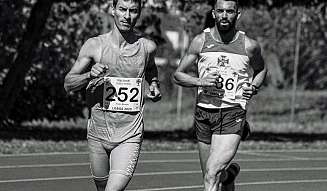
Amateur triathlete Carsten im Brahm (45) from Essen
Top form! Carsten im Brahm is a member of the over-45 national team.
He is not a professional - but he has trained hard for his hobby and is now one of the best German triathletes in his age group. In 1997, Carsten im Brahm (45), a restaurateur from Essen-Kettwig (NRW), fulfilled his big dream: he competed for the first time in the supreme discipline over 3.8 km swimming, 180 km cycling and 42.2 km running. In 2018, he even took part in the Ironman competition in Hawaii.
Do you still remember your first steps in this sport?
Carsten im Brahm: That was a few years ago (laughs). I've always done a lot of sports, especially track and field and middle-distance running. I got into triathlon through my brother, who co-founded the first triathlon club in our hometown Essen in 1984. I then competed in my first competition in 1992.
What did your first equipment look like?
Relatively simple. My bike was a normal racing bike, the helmet an old ice hockey helmet. Compared to the Formula 1 technology used by the professionals today, it was a joke! But that's also the beauty of triathlon: you can start with very simple means. In the popular competitions, anyone who is reasonably fit can actually take part. You can even see a Dutch bike on the bike course.
To do the Ironman, you probably have to train a bit more ...
I prepared for Hawaii for a year, training twelve to 15 hours a week. You first have to qualify, which I did at the European Championships in the summer with a time of 9:51 hours.
But the competition in Hawaii is something else again, isn't it?
Definitely. The heat, the wind, swimming in the open sea, plus the time difference. Everyone pushes themselves to their limits and beyond.
What are your next goals?
I'm looking forward to the World Championships in Lausanne at the beginning of September. Before that, I want to compete in the Ironman distance at the Hamburg Triathlon in July.
Post your comment
Comments
No one has commented on this page yet.
RSS feed for comments on this page RSS feed for all comments
